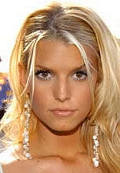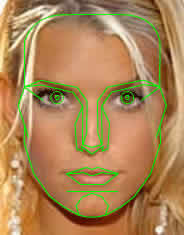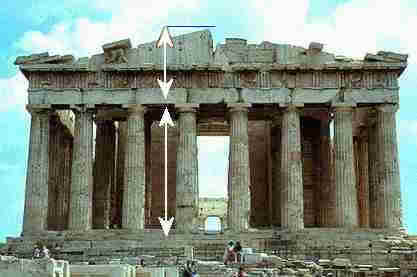By M. Bourne

Jessica Simpson
What has mathematics got to do with beauty? Actually, a lot. Physical attraction depends on ratio.
Our attraction to another person's body increases if that body is symmetrical and in proportion. Likewise, if a face is in proportion, we are more likely to notice it and find it beautiful.
Scientists believe that we perceive proportional bodies to be more healthy.

Leonardo da Vinci's "Vitruvian Man",
showing the golden ratio in body dimensions
Leonardo da Vinci's drawings of the human body emphasised its proportion. The ratio of the following distances is the Golden Ratio:
(foot to navel) : (navel to head)
Similarly, buildings are more attractive if the proportions used follow the Golden Ratio.
Golden Ratio
The Golden Ratio (or "Golden Section") is based on Fibonacci Numbers, where every number in the sequence (after the second) is the sum of the previous 2 numbers:
1, 1, 2, 3, 5, 8, 13, 21, ...
We will see (below) how the Fibonnaci Numbers lead to the Golden Ratio:
Φ = 1.618 033 ...
Physical Beauty
Why do many people feel that Jessica Simpson is beautiful?


Her beauty is mathematical!
You can play with this concept in the following interactive.
Flash Interactive
In this Flash activity, you can check out the "mathematical beauty" (or not) of some famous people.
Choose a mask, depending on whether the person is smiling or not, and line up the mask with the photo, using the sliders.
You can change the colour of the mask for better viewing.
This interactive is based on the work of Dr. Stephen Marquardt (external site).
Further Information
In Elle Magazine, the article "Tech Support" describes the work of Tommer Leyvand, a computer scientist who developed a method of "digital face beautification" using software. You can see some examples of his work at Digital Face Beautification and there's a short PDF explaining the math behind the technique.
Stephen Marquardt developed his "beauty mask" to help him do a better job when performing plastic surgery. See more information on the procedure of plastic surgery.
Disclaimer: Of course, inner beauty is more important than external beauty...!
Back to the Mathematics...
Let's look at the ratio of each number in the Fibonacci sequence to the one before it:
1/1 = 1
2/1 = 2
3/2 = 1.5
5/3 = 1.666...
8/5 = 1.6
2/1 = 2
3/2 = 1.5
5/3 = 1.666...
8/5 = 1.6
13/8 = 1.625
21/13 = 1.61538...
34/21 = 1.61905...
55/34 = 1.61764...
89/55 = 1.61861...
21/13 = 1.61538...
34/21 = 1.61905...
55/34 = 1.61764...
89/55 = 1.61861...
If we keep going, we produce an interesting number which mathematicians call "phi" (Golden Ratio or Golden Section):
Φ = 1.618 033 988 7...
This ratio was used by architects and artists throughout history to produce objects of great beauty (like Michelangelo's "David" and the Greek temples.)

The Parthenon in Greece. The ratio of the distances indicated is the Golden Ratio.
Phi (Φ) is like pi (π) in the sense that it is an irrational number. There is no equivalent fraction for Φ and its decimal keeps going and never stops.
The Golden Ratio also occurs in nature, in the patterns we see in sunflowers, pine cones and so on. This is largely because one of the best ways to efficiently pack things tightly together is using the Fibonacci sequence.

No comments:
Post a Comment